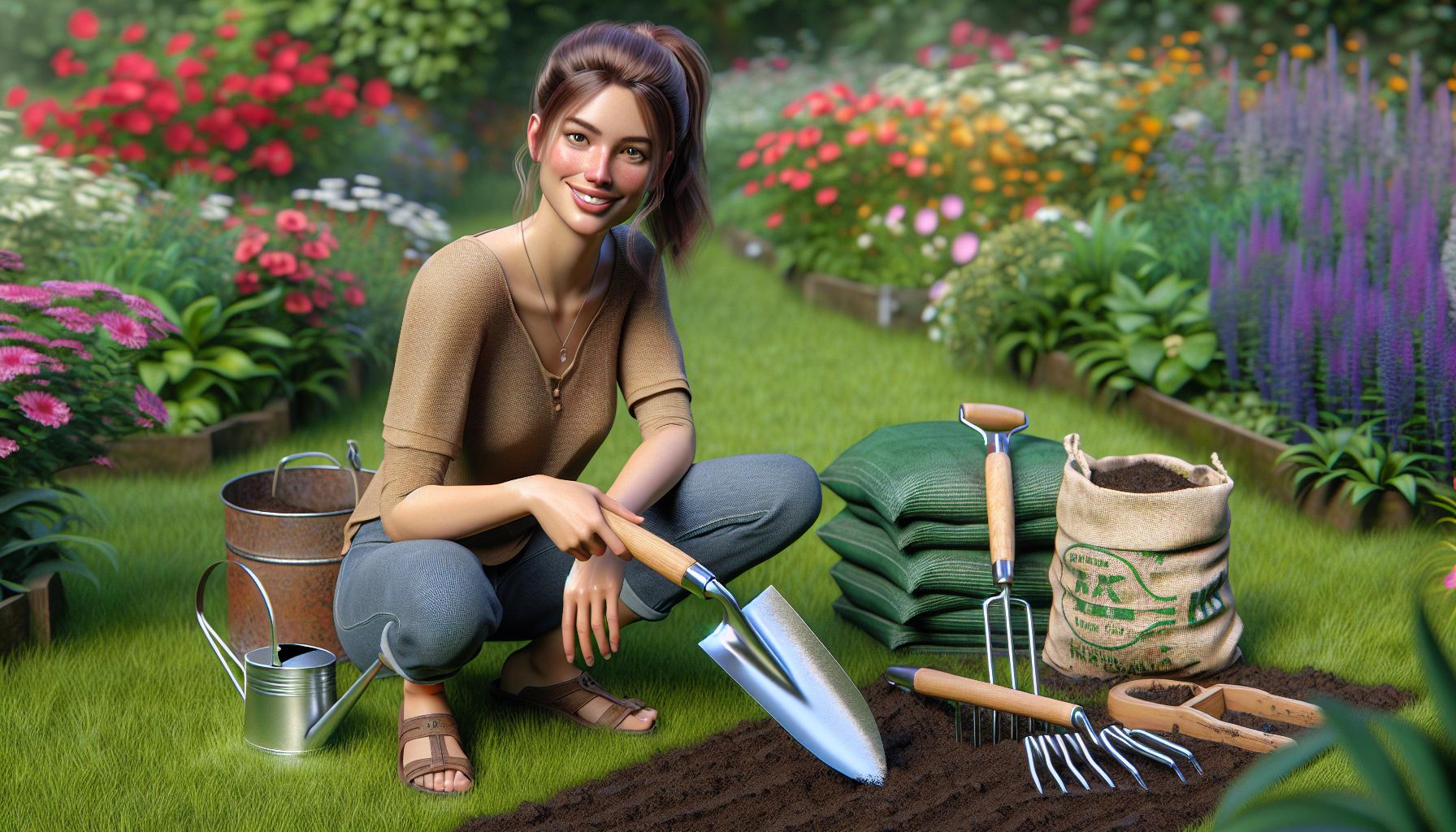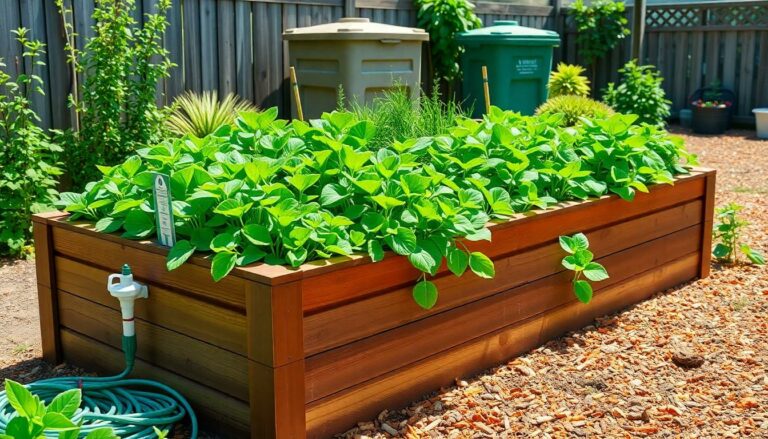As a passionate gardener I know how overwhelming it can feel when you’re just starting out. Walking into a garden center and seeing countless tools can leave your head spinning. But don’t worry – you don’t need every gadget on the shelf to start your gardening journey.
I’ve spent years learning which tools are essential and which ones just collect dust in my shed. Through trial and error I’ve discovered that beginning gardeners really only need a few basic implements to successfully grow and maintain their first garden. In this guide I’ll share my tried-and-true list of must-have gardening tools that’ll help you dig weed and plant with confidence.
Key Takeaways
- Essential gardening tools for beginners include hand trowels, cultivators, pruners, and basic watering equipment like hoses and watering cans
- Quality tools should be made of durable materials like stainless steel and have ergonomic features for comfort during extended use
- Proper tool maintenance involves regular cleaning, disinfecting, sharpening of blades, and oiling of moving parts after each use
- Budget-conscious gardeners can find quality tools by shopping during off-season sales, checking estate sales, and focusing on multipurpose tools
- Basic plant support materials like stakes, cages, and trellises are crucial for growing healthy vegetables and climbing plants
- Protective gear including different types of gloves and knee pads is essential for safe and comfortable gardening
Essential Hand Tools for New Gardeners
I’ve identified these hand tools as the foundation of every gardener’s toolkit, based on 15 years of hands-on experience in various garden settings. These tools deliver the most value for everyday gardening tasks.
Hand Trowels and Cultivators
A stainless steel hand trowel serves as my primary tool for digging planting holes, transplanting seedlings and scooping soil. I prefer a trowel with a 6-inch blade, ergonomic grip and full-tang construction for maximum durability. Hand cultivators complement trowels with their 3-pronged design, perfect for loosening soil, removing weeds and mixing in amendments like compost or fertilizer.
| Tool Type | Primary Uses | Recommended Material |
|---|---|---|
| Hand Trowel | Planting, transplanting, soil moving | Stainless steel |
| Cultivator | Soil loosening, weeding, mixing | Carbon steel |
- Harvesting herbs and vegetables
- Deadheading spent flowers
- Trimming delicate stems
- Cutting twine and garden ties
| Tool Feature | Bypass Pruners | Garden Scissors |
|---|---|---|
| Max Cut Size | ¾ inch | ¼ inch |
| Best Use | Woody stems | Soft stems |
| Blade Type | Curved | Straight |
Must-Have Watering Equipment
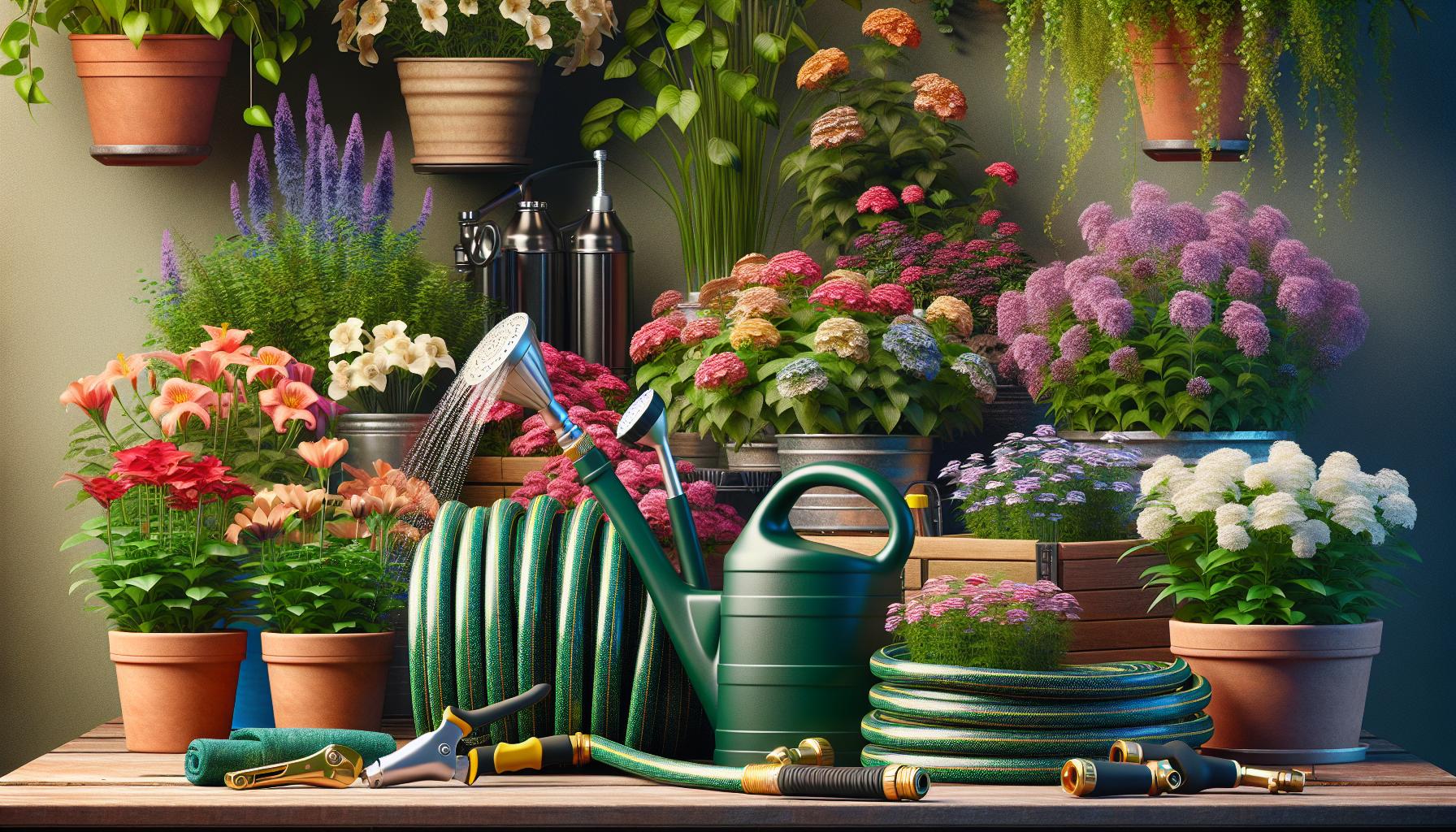
Proper watering equipment forms the backbone of successful gardening, enabling consistent plant hydration throughout the growing season. Here’s my proven selection of essential watering tools based on maintaining gardens of various sizes.
Garden Hoses and Nozzles
A 50-foot flexible rubber garden hose serves as my primary watering tool for outdoor gardens. I’ve found that investing in a 5/8-inch diameter hose with brass fittings prevents kinking and ensures durability across multiple seasons. For precise water control, I pair the hose with these attachments:
- Adjustable spray nozzle with 8 spray patterns (mist, shower, jet, flat)
- Quick-connect coupling system for easy attachment changes
- Hose splitter to connect multiple hoses simultaneously
- Coiled hose holder for organized storage
Watering Cans and Sprinklers
For container gardens and indoor plants, I rely on two watering can sizes:
- 2-gallon plastic can with removable rose head for outdoor containers
- 1-liter stainless steel can with long spout for indoor plants
- Oscillating sprinkler for rectangular garden beds up to 4,000 sq ft
- Rotating sprinkler head for circular coverage up to 80 ft diameter
- Micro-drip irrigation system for container gardens
| Equipment Type | Coverage Area | Water Flow Rate |
|---|---|---|
| Oscillating Sprinkler | 4,000 sq ft | 12 gallons/minute |
| Rotating Sprinkler | 5,000 sq ft | 15 gallons/minute |
| Micro-drip System | 100 sq ft | 1 gallon/hour |
Soil Preparation Tools
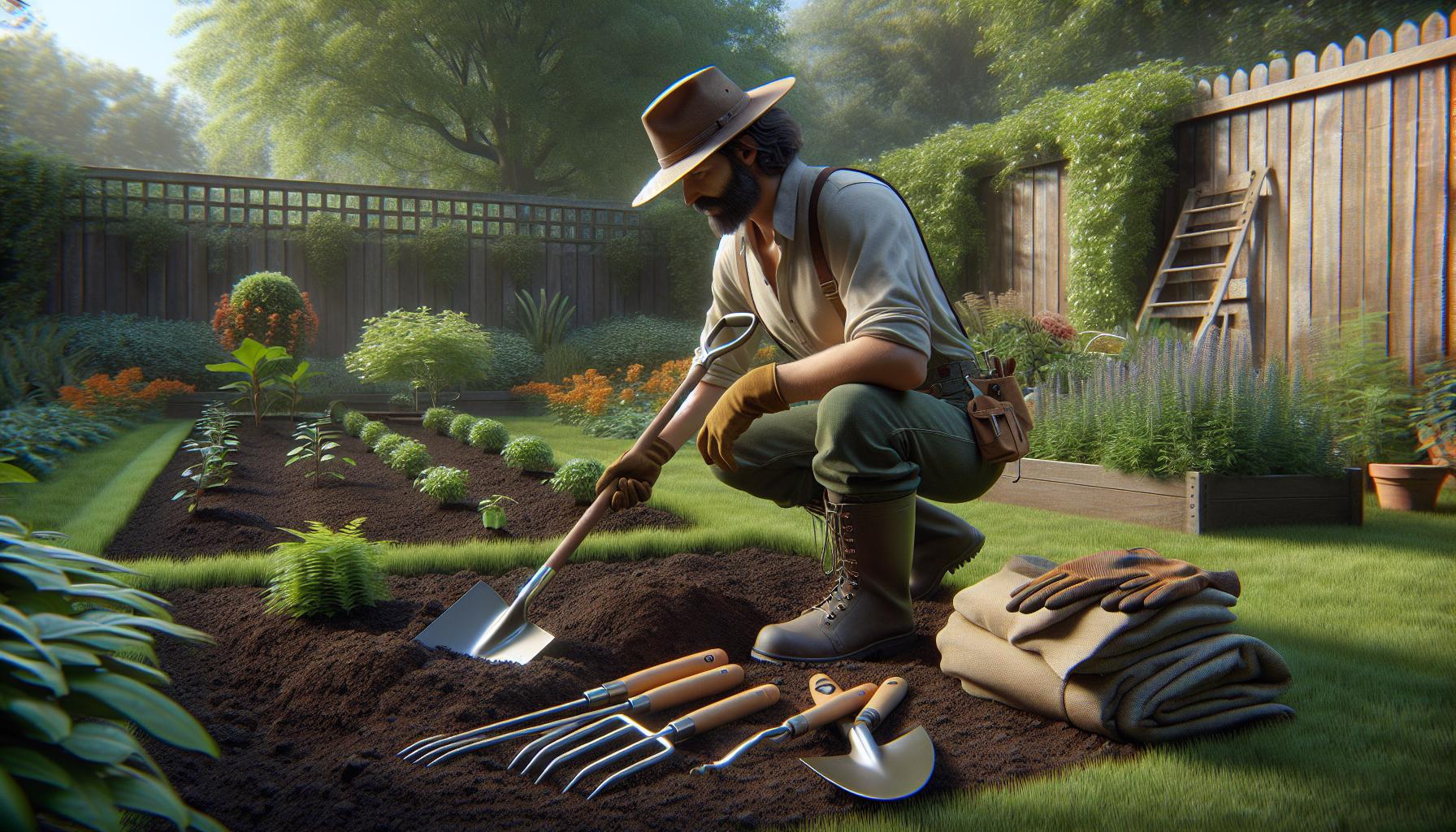
Proper soil preparation creates the foundation for a thriving garden. I’ve identified essential tools that transform compact soil into an ideal growing environment based on my experience working with different soil types.
Garden Spades and Forks
A 28-inch stainless steel garden spade with a D-shaped handle serves as my primary tool for digging planting holes breaking new ground. The flat blade edge cuts through soil cleanly creating straight-sided beds borders while the pointed tip of a garden fork penetrates compacted soil effectively. I use a 30-inch garden fork with four square tines to:
- Loosen dense soil layers without disrupting soil structure
- Turn compost piles to accelerate decomposition
- Harvest root crops like potatoes carrots parsnips
- Break up clay soil when adding amendments
Garden Rakes and Hoes
My collection includes both a 54-inch bow rake for heavy-duty tasks a 48-inch leaf rake for lighter work. The bow rake features 14 steel tines that:
- Level soil surfaces after tilling
- Remove rocks debris before planting
- Incorporate fertilizer amendments evenly
- Create straight furrows for seed planting
- Stirrup hoe: Cuts weeds just below soil surface
- Warren hoe: Creates precise planting furrows
- Dutch hoe: Breaks up soil crust between plants
- Draw hoe: Shapes raised beds mounds
| Tool Type | Blade Width | Handle Length | Best For |
|---|---|---|---|
| Garden Spade | 7 inches | 28 inches | Breaking ground digging |
| Garden Fork | 8 inches | 30 inches | Loosening soil harvesting |
| Bow Rake | 14 inches | 54 inches | Leveling soil debris removal |
| Stirrup Hoe | 5 inches | 54 inches | Precision weeding |
Plant Protection and Support
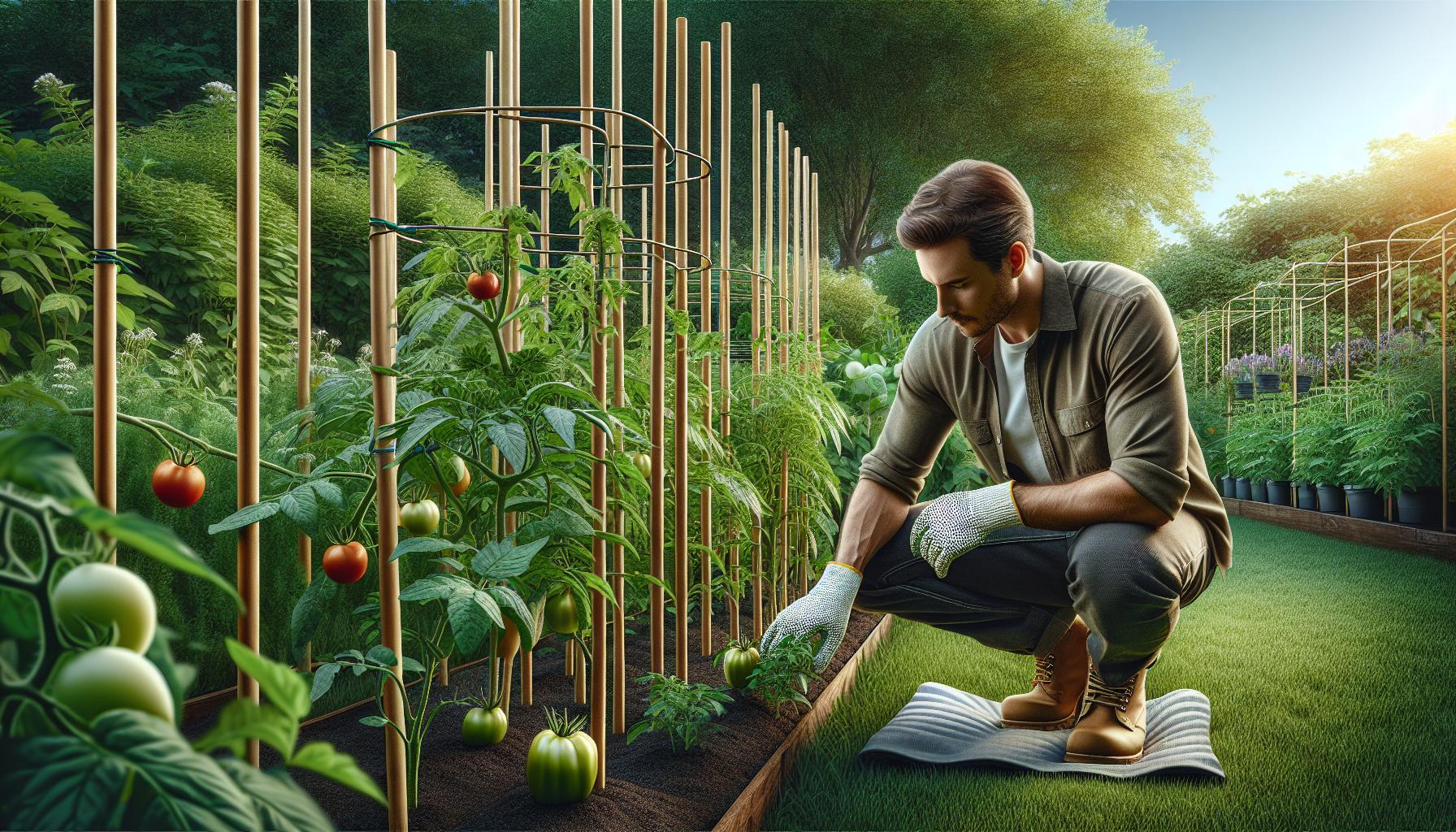
After preparing soil and mastering essential tools, protecting plants and providing adequate support ensures healthy growth and abundant harvests. Here are the essential protective items I’ve found indispensable through years of gardening experience.
Garden Gloves and Knee Pads
I use different types of garden gloves for specific tasks to protect my hands while maintaining dexterity:
- Nitrile-coated cotton gloves for general gardening tasks like planting seedlings
- Heavy-duty leather gloves for handling thorny plants or sharp tools
- Water-resistant gloves for wet conditions or chemical applications
- Memory foam knee pads with water-resistant shells protect joints during extended ground work
- A kneeling pad (18″x11″) serves as an alternative to knee pads for quick tasks
- 6-foot bamboo stakes (¼ inch diameter) for tomatoes and climbing plants
- 3-foot metal stakes for peppers and eggplants
- Soft plant ties (¼ inch width) made from rubber or velcro for securing stems
- Garden twine made from natural jute for temporary support
- Tomato cages (54 inches tall) with 3 support rings for determinate varieties
- Expandable trellis netting (5×15 feet) for vine crops like cucumbers and peas
| Support Type | Height | Best For |
|---|---|---|
| Bamboo Stakes | 6 feet | Tomatoes, Pole Beans |
| Metal Stakes | 3 feet | Peppers, Young Plants |
| Tomato Cages | 54 inches | Determinate Tomatoes |
| Trellis Netting | 5×15 feet | Climbing Vegetables |
Choosing Quality Tools on a Budget
I’ve found excellent gardening tools at reasonable prices by focusing on three key strategies:
Research & Comparison
- Check online marketplaces in January when prices drop 25-40% during off-season sales
- Compare prices across 3-4 major retailers like Home Depot, Lowes & local garden centers
- Read customer reviews focusing on durability & performance ratings above 4 stars
- Monitor deal sites for seasonal discounts on premium brands like Fiskars & Corona
Value-Based Selection
- Choose mid-range tools with stainless steel heads & hardwood handles
- Invest in multi-purpose tools that serve 2-3 functions:
- Garden fork doubling as potato harvester
- Combination hand trowel with measurement markings
- Pruners with built-in wire cutters
- Focus spending on most-used items: hand trowel spade & pruners
Smart Shopping Tips
- Purchase tools in October when stores clear summer inventory at 30-50% off
- Visit estate sales & yard sales for quality used tools at 60-70% below retail
- Check local buy-nothing groups for free secondhand equipment
- Buy basic tool sets containing 3-4 essential items rather than individual pieces
- Clean tools after each use to prevent rust
- Apply mineral oil to wooden handles twice per season
- Store tools in a dry covered area
- Sharpen blades annually using a metal file
- Replace damaged tools immediately to prevent injury
This methodical approach to tool selection saves 40-60% on initial garden setup costs while ensuring quality equipment that lasts 5-10 years with proper care.
Tool Maintenance and Storage Tips
Cleaning and Disinfecting
I clean my gardening tools after each use to prevent rust formation and disease transmission. A wire brush removes soil from metal surfaces while a damp cloth cleans wooden handles. For disinfecting:
- Spray tools with 70% isopropyl alcohol between uses on different plants
- Soak metal parts in 10% bleach solution for 30 minutes each month
- Clean pruning blades with rubbing alcohol after cutting diseased plants
- Apply white vinegar to remove stubborn rust spots
Sharpening and Oiling
Regular maintenance keeps cutting tools sharp and moving parts smooth. My maintenance schedule includes:
- Sharpen pruners diagonally with a diamond file every 3 months
- Oil hinges with 3-in-1 oil monthly to prevent sticking
- Apply linseed oil to wooden handles twice per year
- Use a whetstone on spades and hoes each spring
Storage Solutions
Proper storage extends tool life and keeps the workspace organized. Essential storage methods include:
- Mount pegboard panels with labeled tool outlines
- Install horizontal PVC pipes to hold long-handled tools
- Use magnetic strips for small metal hand tools
- Store power tools in weatherproof containers with silica gel packets
Seasonal Care
Different seasons require specific maintenance approaches:
| Season | Maintenance Tasks |
|---|---|
| Spring | Deep clean tools resharpen blades apply wood preservative |
| Summer | Weekly cleaning inspect for loose handles tighten as needed |
| Fall | Oil metal surfaces check for rust spots repair or replace damaged tools |
| Winter | Clean thoroughly store in dry location wrap metal parts in oiled cloth |
- Mobile garden cart with dedicated compartments
- Wall-mounted tool racks with adjustable hooks
- Storage bench with built-in tool slots
- Weather-resistant storage cabinet with ventilation
Conclusion
Starting your gardening journey doesn’t have to be overwhelming. I’ve shared my tried-and-true recommendations for essential tools that’ll help you create and maintain a thriving garden without breaking the bank.
Remember that quality matters more than quantity. I’ve found that investing in a few well-made basic tools and maintaining them properly serves me better than having a shed full of rarely-used equipment.
As you develop your green thumb I’m confident these foundational tools will become trusted companions in your gardening adventures. Now it’s time to get your hands dirty and watch your garden grow!

